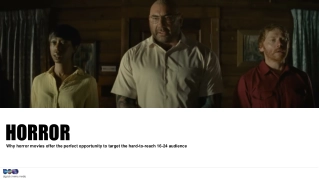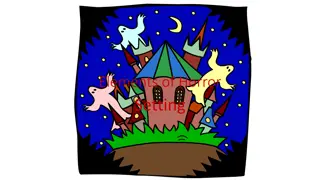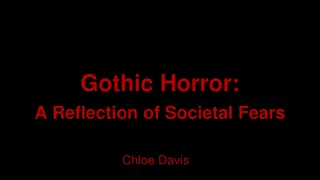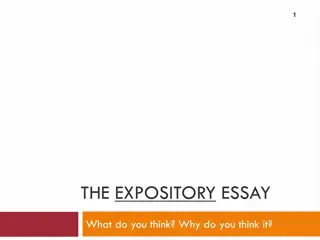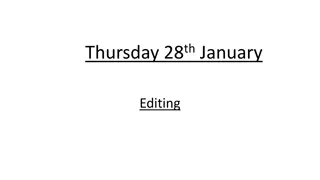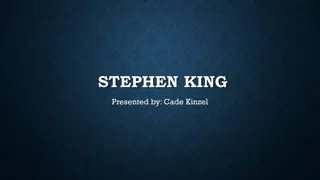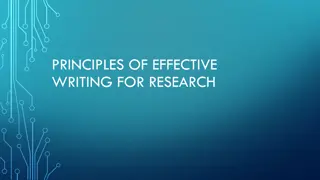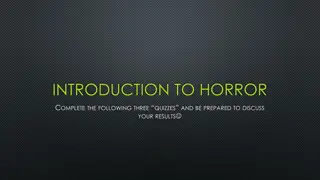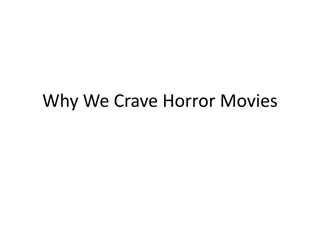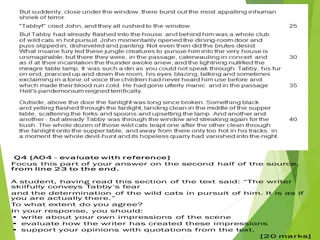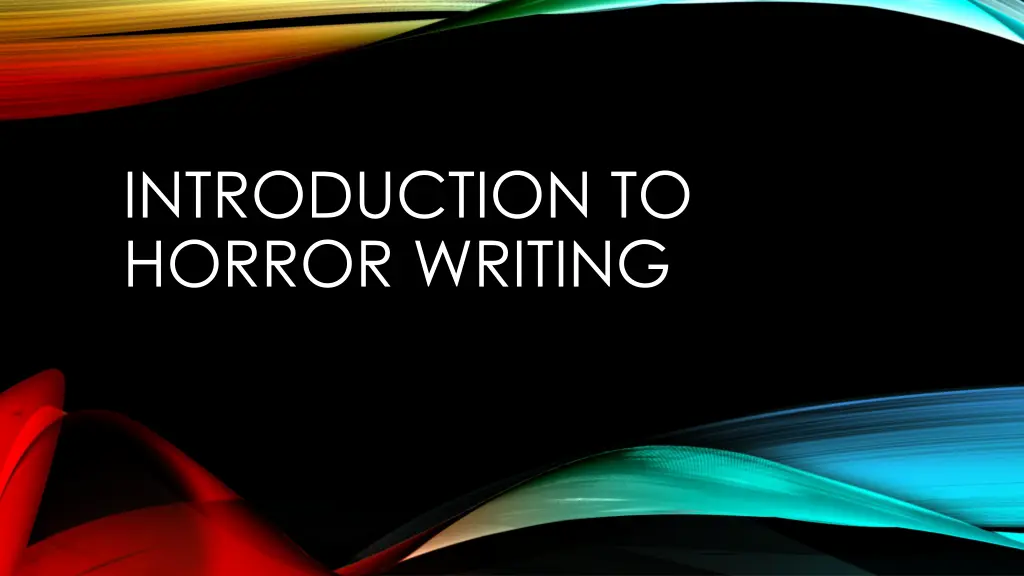
Exploring the Depths of Horror Writing
Dive into the rich history and elements of horror literature, delving into the evolution of fear as a driving force behind storytelling. Discover the archetypal characters, settings, and subcategories that make up the spine-chilling genre of horror writing.
Download Presentation

Please find below an Image/Link to download the presentation.
The content on the website is provided AS IS for your information and personal use only. It may not be sold, licensed, or shared on other websites without obtaining consent from the author. If you encounter any issues during the download, it is possible that the publisher has removed the file from their server.
You are allowed to download the files provided on this website for personal or commercial use, subject to the condition that they are used lawfully. All files are the property of their respective owners.
The content on the website is provided AS IS for your information and personal use only. It may not be sold, licensed, or shared on other websites without obtaining consent from the author.
E N D
Presentation Transcript
INTRODUCTION TO HORROR WRITING
BACKGROUND The oldest and strongest human emotion is fear. It is embedded in people since time began. It was fear that initiated the establishment of faith and religion. It was the fear of unknown and mysterious phenomena, which people could not explain otherwise than via impersonating a high power, which decides their fates. To every unexplainable phenomenon they attributed a character, human or inhuman, which they associated with supernatural skills and invincible power. Since the human imagination knows no limits, a wide scale of archetypal characters have been created, such as gods, demons, ghosts, spirits, freaks, monsters or villains. Stories and legends describing their insurmountable power started to spread about them. Despite the fact by the development of science many so far incomprehensible phenomena have been explained, these archetypes and legends are still being used in literature and other branches of art. Three genres are based on fear and imagination: science fiction, fantasy and horror, which together form a so-called fantastic triangle. It is why they so often overlap and enrich themselves.
THE LITERATURE OF HORROR Unlike science fiction and fantasy, the definitions of the genre of horror do not stand on the structure of various works; they rather focus on the esthetic aspect and emotions, which are evoked in the readers (fear, horror, anxiety etc.) Based on this, horror is defined as a genre of popular literature focused on evoking emotions of dread, fear and tension. 4 (Mocn - Peterka) One of the attributes of horror are some typical archetypal characters: vampire, werewolf, zombie, monster, mad scientist, demon, ghost, eternal wanderer, serial killer, psychopath, bad child, possessed person, and antichrist. The genre is characterized by dynamism, and therefore it is necessary to note that these are only just a few of the archetypes, because they keep evolving along with the genre and new archetypal characters are created perpetually. Another of the genre s dominants is the environment in which the story is revolving. First, these were places out of the modern world, such as cemetery, abandoned castle, gloomy forest, castle ruins, old house etc. Most of all, these are places intensively charged with mystery that have their own lives . This is also true for the modern environment that cuts its way into the modern horror.
HORROR AS A GENRE: CATEGORY #1 THE UNCANNY The end of the story contains elements of supernatural, events that seem to be unreal, impossible or irrational, or events that follow the laws of rational but are incredible, disturbing, unusual, shocking, unexpected or unique. The viewer/reader has an opportunity to explain them in their own way. Yet the laws of reality remain untouched. Examples of this category are the following films: Taste of Fear (1961), Nightmare (1964), Psycho (1960), or films that overlap with the genre of science fiction. Extraterrestrials can be inhuman but not unnatural; they represent the boundaries of human knowledge.
HORROR AS GENRE CATEGORY #2 THE MARVELOUS HORROR Seemingly irrational and incomprehensible phenomena can be explained only by accepting the second layer of reality the supernatural while the story lasts. To explain the incomprehensible phenomena of the story we must accept the new laws of nature . Films of vampires, werewolves, living dead, demons etc. represent this category.
HORROR AS GENRE: CATEGORY #3 FANTASTIC HORROR Does not allow us clear explanations of the irrational; it offers us several alternatives. The viewer/reader can decide whether they will explain the phenomenon as the existence of the paranormal or as a hallucination of the main protagonist. The fantastic horror raises doubts and hesitation between the natural and supernatural alternative, which the recipient may (or may not) share with the character. Examples are film such as Shining (1980), Cat People (1942) The Innocents (1920) or I Walked With a Zombie (1943).
SUBGENRES THAT INTERSECT WITH THREE CATEGORIES Rural horror, also known as redneck horror, is not related to specific locations only (such as villages or country). It is the horror that is situated in places far from civilization, which also includes a local legend, myth or superstition. These are horrors such as Hills Have Eyes (1977, remake 2006, sequel 2007), The Evil Dead (1981), Cabin Fever (2002), Deliverance (1972) or Wrong turn (2003). Cosmic horror is mostly characterized by the work of Howard Phillips Lovecraft. In his books he wrote of a civilization coming from outer space, which conquered the Earth before humankind. Cosmic horror implies elements of science fiction and depicts emotions when a person finds out something he would rather not know about. Including Lovecraft s works we can also mention the works of Clive Barker, Peter F. Hamilton or The King in Yellow by Robert W. Chambers. Apocalyptic horror deals with the end of the world caused by various factors. Therefore it is also called the endof-the-world horror and it is represented by works such as The Stand of The Cell, by Stephen King or the works of Robert McCammon.
SUBGENRES THAT INTERSECT WITH THREE CATEGORIES Crime horror compounds the elements of crime/detective story and horror. It is based on a criminal plot and escalating tension with an addition of horror elements. This category includes films as Resurrection (1999) Se7en (1995) or the Italian Tenebre (1982). Erotic horror combines the sensual or sexual imagery with horror overtones or elements of the plot. The most famous archetypes of the erotic horror are the vampires. Authors such as Wrath James White, Lucy Taylor, Clive Barker, Anne Rice, Michael Garrett, Amy Wrench or Jeff Gelb represent this subgenre. Occult horror focuses on exorcism, the arrival of the antichrist, cults, mysticism, curses and a wide scale of so called occult sciences. Horrors such as The Exorcist (1973 and the related sequels and prequels), Constantine (2005), The Amityville Horror (2005), The Omen (1976, remake 2006) or Final Destination (2000) are only a few examples representing this subgenre.
SUBGENRES THAT INTERSECT WITH THREE CATEGORIES Psychological horror is based on the fear of the main protagonist, on his feelings of guilt, on his faith and unstable emotional state of mind. Further on it develops the plot, the tension and horror as seen in films such as The Sixth Sense (1999), The Blair Witch Project (1999), American Psycho (2000), Harris s cannibal series about Hannibal Lecter Red Dragon (2002), Silence of the Lambs (1991), Hannibal (2001) and Hannibal Rising (2007); The Ring (2002, which is the American remake of the original Japanese horror Ringu from 1998) or the novel of Stephen King called Gerald s Game. The aim of the surreal horror is not only to tell a terrifying story, but to disturb the recipient as well. Besides the classical elements of horror this subgenre also contains elements of surrealism: dreaminess, grotesqueness, bizarreness and the fantastic. Good examples are the works of David Lynch or David Cronenberg, Jacob s Ladder (1990) or Angel Heart (1987). Visceral horror is the most shocking and disturbing of all the subgenres of horror. It is full of blood, gore and brutality. It depicts the most disgusting and most perverse forms of murder, butchering and mutilation of human body. Films such as The Texas Chainsaw Massacre (1974, its sequel, remake and prequel), Saw (2004 and the following sequels), Hostel (2005 and the following sequels), or the works of Jack Ketchum are the most famous representatives of this subgenre.
NARRATIVE STRUCTURE Standard Chronological Structure with beginning, middle, end (Conflict, Struggle, Realization) Often there is heavy foreshadowing to build tension The problem the protagonist faces is caused or exacerbated by being isolated, unprepared, or naive The narrative is built to cause tension, anxiety, and fear in the audience Story plays on standard human fears: the dark, strangers, isolation, death, violence, insanity, creepy monsters
POPULAR SETTINGS Hospitals, Insane Asylums, Mental Institutions or Hotels (long hallways and lots of rooms) Graveyard or Cemetery Churches or Convents Isolated communities or remote locations (cabin, abandoned mansion, haunted house, ghost town, farm field, dark woods, tunnels) deserted places Basements, Attics, Science Labs
POPULAR MOTIFS IN HORROR Good vs. Evil Religion and the Supernatural or Beyond Death Nightmares, Madness, Insanity, Suicide Childhood Fears and Issues Revenge Science gone bad Murder, Death, Hate Darkness, Demons, Satanic Ritual
TYPICAL CHARACTER TYPES Hero (protagonist usually lives) fights villain Victims (protagonists usually die) often are immoral teenagers, stupid beautiful young women Villain (antagonist evil force aliens, vampires, creepy children, monsters, ghosts, demons, zombies, clowns, possessed toys, scary creatures) Police or Helpful authorities may be good or evil
POPULAR PROPS/VISUALS Dark colored clothes, costumes, settings Weapons (rarely guns usually a stabbing or cutting weapon like knives, scythes, axes, chainsaws) Religious or Demonic Symbolism Blood. Lots of blood. Monsters (vampires, evil scientist, werewolves, zombies, possessed people, mass murderer) Lots of black and red Mirrors, masks, peepholes, stalking, chasing Running and then tripping and falling (being chased)


